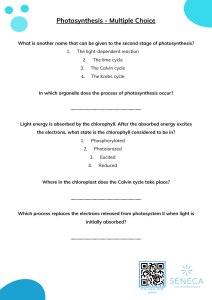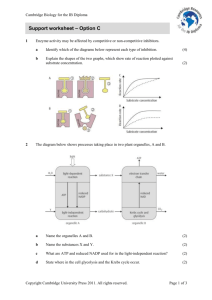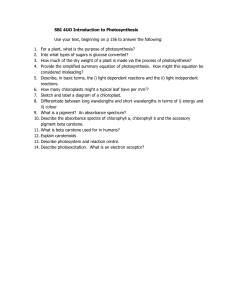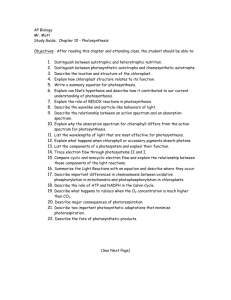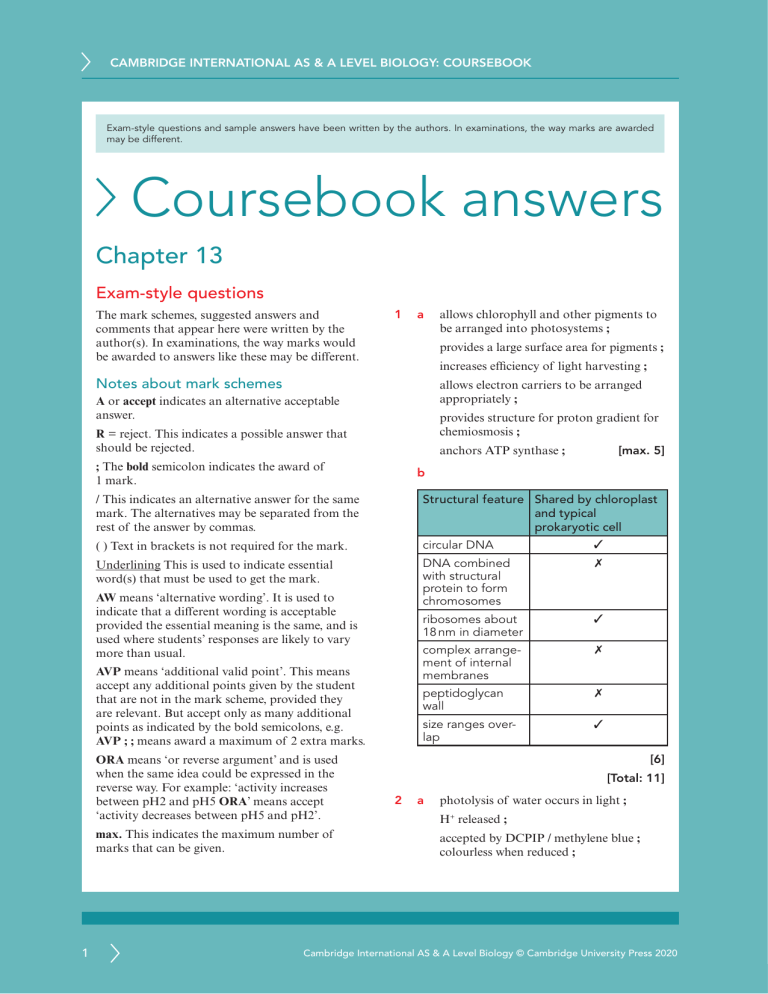
CAMBRIDGE INTERNATIONAL AS & A LEVEL BIOLOGY: COURSEBOOK Exam-style questions and sample answers have been written by the authors. In examinations, the way marks are awarded may be different. Coursebook answers Chapter 13 Exam-style questions The mark schemes, suggested answers and comments that appear here were written by the author(s). In examinations, the way marks would be awarded to answers like these may be different. 1 a allows chlorophyll and other pigments to be arranged into photosystems ; provides a large surface area for pigments ; increases efficiency of light harvesting ; Notes about mark schemes allows electron carriers to be arranged appropriately ; A or accept indicates an alternative acceptable answer. provides structure for proton gradient for chemiosmosis ; R = reject. This indicates a possible answer that should be rejected. anchors ATP synthase ; ; The bold semicolon indicates the award of 1 mark. b / This indicates an alternative answer for the same mark. The alternatives may be separated from the rest of the answer by commas. Structural feature Shared by chloroplast and typical prokaryotic cell ( ) Text in brackets is not required for the mark. circular DNA ✓ Underlining This is used to indicate essential word(s) that must be used to get the mark. DNA combined with structural protein to form chromosomes ✗ ribosomes about 18 nm in diameter ✓ complex arrangement of internal membranes ✗ peptidoglycan wall ✗ size ranges overlap ✓ AW means ‘alternative wording’. It is used to indicate that a different wording is acceptable provided the essential meaning is the same, and is used where students’ responses are likely to vary more than usual. AVP means ‘additional valid point’. This means accept any additional points given by the student that are not in the mark scheme, provided they are relevant. But accept only as many additional points as indicated by the bold semicolons, e.g. AVP ; ; means award a maximum of 2 extra marks. ORA means ‘or reverse argument’ and is used when the same idea could be expressed in the reverse way. For example: ‘activity increases between pH2 and pH5 ORA’ means accept ‘activity decreases between pH5 and pH2’. max. This indicates the maximum number of marks that can be given. 1 [max. 5] 2 [6] [Total: 11] a photolysis of water occurs in light ; H+ released ; accepted by DCPIP / methylene blue ; colourless when reduced ; Cambridge International AS & A Level Biology © Cambridge University Press 2020 CAMBRIDGE INTERNATIONAL AS & A LEVEL BIOLOGY: COURSEBOOK shows ‘reducing power’ of chloroplasts ; [max. 4] b NADP ; [1] a concentration of carbon dioxide ; temperature ; a light-dependent photochemical stage ; electron emitted by chlorophyll of photosystem II does not return to that chlorophyll (but is absorbed by photosystem I and electron emitted by photosystem I is absorbed by NADP) ;[2] a light-independent temperaturedependent stage ; photochemical reactions are not affected by temperature ; photophosphorylation: at low light intensities, light intensity is the rate-limiting factor ; synthesis of ATP using light energy in photosynthesis in a chloroplast ; at high light intensities and low temperatures, temperature is the ratelimiting factor ; [max. 5] oxidative phosphorylation: c [2] 6 a of different wavelengths of light by a compound ; NADP: hydrogen carrier in photosynthesis ; action spectrum: [2] [Total: 6] a and b CO2 (1C) absorption spectrum: a graph of the absorbance ; hydrogen carrier in respiration ; 4 [Total: 10] NAD: [4] c shows that there are two sets of reactions in photosynthesis ; non-cyclic photophosphorylation: synthesis of ATP using energy released from the electron transport chain in aerobic respiration in a mitochondrion ; light intensity ; light wavelength ; cyclic photophosphorylation: electron emitted by chlorophyll of photosystem I returns to chlorophyll by a series of carriers ; b a limiting factor: one factor, of many affecting a process, that is nearest its lowest value and hence is rate-limiting ;[1] b [Total: 5] 3 5 rubisco active here a graph of the rate of a process ; e.g. photosynthesis at different wavelengths of light ; [4] b number of bubbles shows rate of photosynthesis ; rate similar at 450 nm (blue) and 650 nm (red) ; these are wavelengths that are absorbed by chlorophyll ; rate, much lower / refer to figures, at 550 nm (green) ; RuBP (5C) GP/PGA (3C) very little absorbed by any pigment ; [max. 4] [Total: 8] triose phosphate (3C) [Total: 5] 2 Cambridge International AS & A Level Biology © Cambridge University Press 2020
